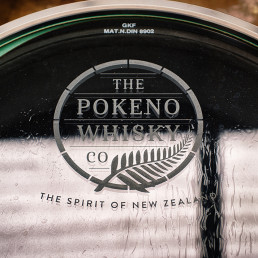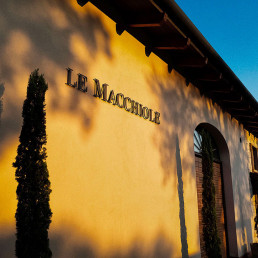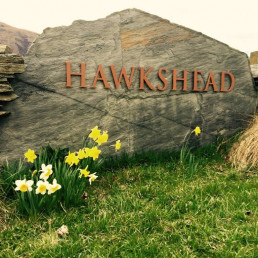Dhall & Nash is primarily all about wine, so if you don’t fully understand the intricacies of the world of whisky, don’t fret. We’re going to give you a crash course.
Last month we announced the arrival of Pōkeno Whisky into our portfolio. Off the back of this, and the arrival of the latest Whisky Cellar series, we thought it was about time to dig down.
Whisky or Whiskey?
Same idea, different origins. ‘Whisky’ with no ‘e’ are spirits from Scotland traditionally while ‘Whiskey’ is the Irish spelling.
Canada, Japan and New Zealand all favour the Scottish vernacular while the United States leans toward the Irish. There are some region-specific rules when it comes to the Irish and Scotch Whisk(e)y;
- Whisky (Scotch) must be made in Scotland and must mature in oak three + years and to be labeled ‘Single Malt’ it must be made from 100% malted barley. It must be more than 40% ABV at bottling.
- Whiskey (Irish) can contain a mix of malt, a barley distillate and a portion of grain spirit – it is usually triple distilled and uses less peat than Scotch styles. It also must age more than three years.
For Pōkeno Whisky, the rules are out the door and exploration is the name of the game. For The Whisky Cellar, they will be adhering to the Scotch rules.
Wildcard: Bourbon is an American take on whisk(e)y, utilising corn in its production.
What’s in it?
Whisky is a grain-based spirit, in essence. No matter where it’s from and what regional rules have been applied, this always remains true.
The distillers choice of grains is known as their ‘mashbill’. The distilleries prepare their grain/s, then ferment, distill and age their spirits.
Single Malts use 100% malted barley, and Irish whiskies and other grain whiskies use a percentage of malted barley but also can contain other grains such as maize, wheat, and rye. To be ‘Single’ grain it must be produced at one distillery.
Blended whiskies are, well, blended. They can contain both grain whiskies and malt whiskies.
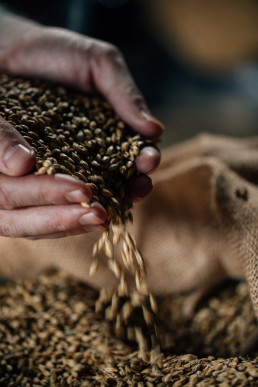
Turning Grain into Whisky
There’s really only three ‘ingredients’ in the whisky making process – the grain, the water and the yeast.
The distillery will source their grain, be it malted barley, wheat, rye, or maize. (In Pōkeno’s case, 100% barley grown by three family-owned farms in the South Island of Aotearoa New Zealand.)
To ‘malt’ the barley, the grains are soaked in water to start the process of germination before they’re processed. Enzymes get activated in this phase that convert the starches into sugars called ‘maltose’. Once the germination starts, it’s halted with hot, drying air in a kiln. This is the stage where some distillers will add peat to their fire to impart the flavours that whisky became known for in eras past when peat was the most commonly used fuel for kilns.
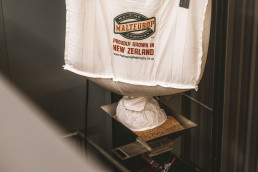
The grains are taken and ‘milled,’ meaning they’re coarsely ground up by rollers. The resulting product is called ‘grist’ and contains all the grain husks as well as chunky bits (‘grits’) and fine, floury powder. The ratio of these components even at this stage of the process is crucial as it affects how the liquid eventually flows through it. The aim is usually for around 70% grits, 20% husk and 10% flour.
The next stage is ‘mashing’. The grist has hot water added to it, which aids the enzymes created in the malting stage to start dissolving the sugars. The temperature of this process is a fine line to toe as it’s important to not kill the enzymes but to get it hot enough to make the magic happen. This is usually between 65 – 70°C, and the finished liquid is called the ‘wort’, which is then drained out for the next stage. This is why the texture of the grist is crucial – too fine and it gets clumpy and stuck, but too rough and the liquid drains too fast to extract the sugars effectively.
What happens to the soggy grains left over? Usually they’re set aside to make animal feed at this point, lucky chickens.
The liquid ‘wort’ is cooled down, ready for fermentation in vats called ‘washbacks’. Similar to wine fermentation, this is the process wherein yeasts are added and will break down the sugars available into alcohol and carbon dioxide. Once this process slows, the ‘wash’ as it’s now known is still under 10% ABV, and this is when the second bacterial fermentation starts.
The fermentation process is usually around 72 hours, but in Pōkeno’s case, they ferment for 90 hours to achieve the style they like.
The product, however long the distiller has chosen to ferment for, is then ready for distillation. Scottish distillers must use a pot still made of copper in a process known as batch distillation, and many other places choose to do so as well. The liquid is heated to around 78°C, where the alcohol boils and vapour rises into a condenser. The product is now called ‘low wines’ (it’s not wine!) is about 20% ABV at this point, and can then be refined through further distillation.
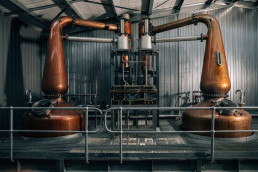
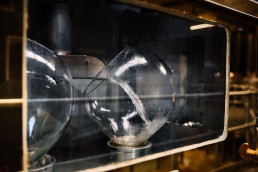
These repeated distillations allow the distiller to separate the less desirable compounds as they tend to distill off first (‘foreshots’) and last (‘feints,’ sorry, we’ll put a glossary at the bottom.)
Think of Goldilocks – the first lot is too volatile, the end lot too oily, but the middle… is just right. This is called the “heart of the run” and usually comes out a little under 70% ABV.
The ‘heart of the run’ is now ready for maturation. Scotch whisky must age in oak in Scotland for at least three years, but beyond that, here is where each distiller can impart more characters and flavours with their choices.
‘Oak’ leaves a surprisingly large amount of room for experimentation though, and distillers use refilled (and freshly charred) casks from a variety of different products to provide interesting and unique layers to the spirit…
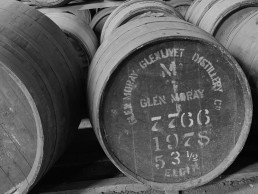
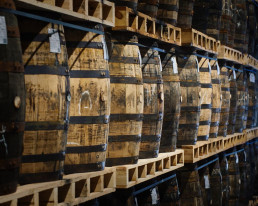
Cask Differences
The decision of which cask the whisky will mature in is hugely impactful, so let’s outline the common ones you’ll see;
- “Ex Bourbon”: Bourbon Whiskey in America has to be matured in American Oak first fill barrels, which means once they’re used they’re on-sold to other distilleries. These give a smooth, vanilla edge to the whisky and they will be lighter in colour.
- “Ex Sherry”: Rich ‘fruit and nut’ flavours and darker colour, but dependant on which type of sherry;
- Amontillado: notes of dried nuts, tobacco, and floral herbs
- Fino: notes of almonds, pastries, and grassy herbs
- Manzanilla: a dry characteristic with salty notes, and a floral edge
- Moscatel: dry, delicate character with floral notes
- Oloroso: notes of red fruits, berries, milk and nut chocolate
- Palo Cortado: rich and sweet with notes of spice and fruits
- Pedro Ximénez: sweet notes of dark red fruits, raisins, plums
- “Ex Wine”: Can impart flavours of the wine, for example pinot barrels can be earthy and merlot barrels can be plummy.
- “Ex Port”: Port barrels again differ with the style of port, but the common factors are fruity elements like berry.
- “Ex Sauternes”: Adds sweet, honeyed notes with characteristic apricot and candied peel notes.
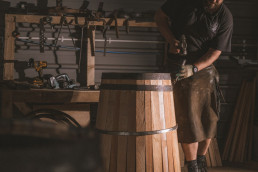
Though maturation in oak is mandatory for Scotch and by and far the most popular choice elsewhere too, there’s room for more experimentation here in lil ol’ NZ. Pōkeno is leaning right into the “spirit” of kiwi ingenuity (pun intended,) within their own cooperage – NZ’s only one – trying their hand at making casks from native New Zealand wood such as Totara and Kauri.
There are also different sizes to the casks which make considerable difference to how the whisky develops;
- Quarter Cask 50 L
- Barrel 200 L
- Hogshead 225-250 L
- Butt <500 L
- Pipe <650 L
The smaller the vessel, the more the cask surface is in contact with the spirit. This means the smaller the cask size the more the flavours from the wood can impart themselves, sometimes meaning the maturation period required to nail the desired flavour can be reduced.
(Top Whiskies has an excellent table displaying the different sizes and the corresponding data, for those wanting an even deeper rabbit hole.)
How They Age and the “Angel’s Share”
While the wooden casks the whisky ages in holds the spirits well, they are slightly porous. Over time, the spirit ever so slowly starts to evaporate and concentrate. The component lost is commonly referred to as “The Angel’s Share,” and is seen as a bit of a heavenly sacrifice in exchange for making the whisky as good as it can be.
At the start, the whisky evaporates somewhat quickly. The average in Scotland is around 1-2% per year. The rate slows after the first few years, but doesn’t actually stop – some whiskies can lose up to 40% of their volume in cask over a few decades.
(In Pōkeno, the angels are greedy. With evaporation rates of over 9% per year, the climate accelerates the maturation and flavour development of their single malts.)
Smaller casks can contribute to faster evaporation rates because of the higher wood contact.
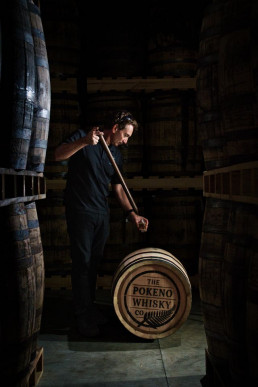
But what the angels are drinking is a bit different to what you will be – you can thank them for their hard work later. The components that evaporate during the maturation change the whisky concentration – the spirit that goes into the barrel at the start is strong, usually just under 70% ABV and not overly nuanced yet from wood influence. The ethanol content (alcohol) and the water content of the whisky evaporate at different rates. With the alcohol content escaping the barrel at a faster rate than the water content, the early angels likely need a chaser.
This is why older whiskies with longer maturation times usually have a lower alcohol percentage (but well-integrated flavours from all that time in cask.)
How to Drink Whisky
So now that the grain has been malted, mashed, fermented, distilled, matured and bottled, it’s time to enjoy it. How you enjoy it is entirely up to you, but there are some practices that are more widely accepted.
The Glass
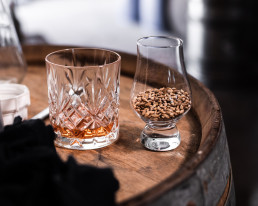
In the movies, the fine cut crystal tumbler is pretty iconic, so if that’s your vibe we wholeheartedly encourage you to pursue your movie star dreams and brood in front of a fireplace, but there are glasses more equipped to deliver the best whisky experience.
More ‘tulip’ shaped dram glasses offer the same benefits that wine glasses with smaller tops do: swirlability.
Being able to swish the liquid around and expose it to air while concentrating the aroma up through the opening makes for a much more rounded sensory experience. Better visibility of colour and legs, better aroma as it wafts up, and easily sippable.
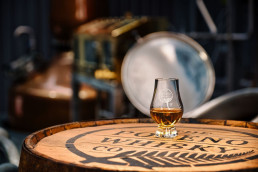
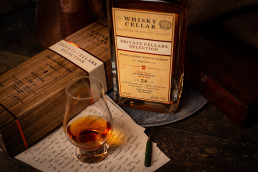
These glasses are often called Glencairn glasses (in the same way some call vacuum cleaners “Hoovers” or tissues “Kleenex”). Glencairn Crystal Ltd near Glasgow was the first to develop the glass, inspired by traditional nosing copitas used in whisky labs around Scotland and designed under the guidance master blenders from five of the largest whisky companies in Scotland. The Tasting Table explains;
“It’s quite simple, every whiskey enthusiast needs a Glencairn glass or a suitable substitute… The narrow opening also allows you to easily control the pour into your mouth to gradually appreciate the palate.”
Additions?
We know whisky based cocktails and mixers exist but for the sake of learning to appreciate great whisky like Pōkeno or The Whisky Cellar, you’ll want to know about three variations: neat, on the rocks, or with water.
‘Neat’ is literally a splash of whisky in your glass, no additions. This allows you to experience it exactly as it came from the distillery and offers concentrated flavours. It also allows you to control the temperature more accurately.
‘On the Rocks’ is to add ice. This quickly cools the whisky and over time as it melts, offers slightly different flavour profiles as it dilutes.
Whisky with water doesn’t have a nickname, but is exactly as it is described. A splash of water (not too much! 20% water is considered about right,) added to your whisky can help to take the ‘edge’ off and give the flavours and layers more ‘room’ to breathe and present themselves.
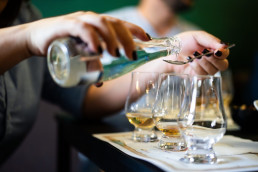
Temperature comes into the debate a lot, as it’s understood you should drink whisky at room temperature. When this was first a ‘thing’ though, the ambient room temperature tended to be a bit cooler so chilling the whisky down just a little is preferred by some people. This is why, of the three variations, ‘on the rocks’ is the most controversial. It inevitably gets colder than it should get at the beginning before offering the graduated dilution and warming. The whisky you drink in your first sip will be quite different to the last. More power to you if this is your preference, though!
Whisky Stones? Again, if you enjoy it, absolutely go for it – but don’t tell our resident whisky nut, Nigel, as he will probably judge you for these.
Glossary
(Yeah, we needed this too)
- Whisky: The Scottish spelling
- Whiskey: The Irish spelling
- Dram: A drink of whisky
- Mashbill: The distillers blend of grains
- Malt (ing/ed): The partial germination of the barley before processing
- Peat: Dense, partially decomposed plant matter that used to be used as fire fuel, imparting a particular flavour that became favoured. It is now added to the modern kiln fires as a stylistic choice as opposed to a fuel source.
- Milling: The grinding of the grains
- Grist: The result of the milling process, containing ground grains
- Grits: The larger sized pieces of grain in the grist
- Mash/ing: The process of adding heated water to the grist to create the wort
- Wort: The liquid that results from the mashing
- Washbacks: The vats used in fermentation process
- Wash: The first alcoholic liquid that will become the whisky, usually <10% ABV
- Low wines: The result of the first distillation run, usually around 20% ABV
- Foreshots: The early distillation passes, usually with unwanted characteristics
- Feints: The later distillation passes, usually with unwanted characteristics
- Heart of the run: The middle distillation passes, usually around 70% ABV and with desirable characteristics
- Angel’s Share: The portion of whisky that evaporates during the maturation process
- Glencairn: A glass style developed especially for enjoying whisky

